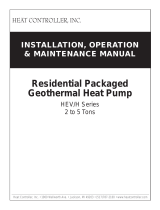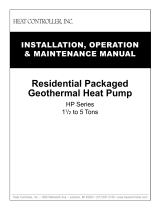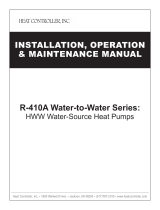
3
GENERAL INFORMATION
Inspection
Upon receipt of the equipment, carefully check the shipment
against the bill of lading. Make sure all units have been
received. Inspect the packaging of each unit, and inspect
each unit for damage. Insure that the carrier makes proper
notation of any shortages or damage on all copies of the
freight bill and completes a common carrier inspection
report. Concealed damage not discovered during unloading
must be reported to the carrier within 15 days of receipt of
shipment. If not filed within 15 days, the freight company
can deny the claim without recourse. Note: It is the
responsibility of the purchaser to file all necessary claims
with the carrier. Notify Heat Controller, Inc. of all damage
within fifteen (15) days of shipment.
Storage
Equipment should be stored in its original packaging in
a clean, dry area. Store units in an upright position at all
times. Stack units a maximum of 3 units high.
Unit Protection
Cover units on the job site with either the original packaging
or an equivalent protective covering. Cap the open ends
of pipes stored on the job site. In areas where painting,
plastering, and/or spraying has not been completed, all
due precautions must be taken to avoid physical damage
to the units and contamination by foreign material. Physical
damage and contamination may prevent proper start-up and
may result in costly equipment clean-up.
Examine all pipes, fittings, and valves before installing
any of the system components. Remove any dirt or debris
found in or on these components.
Pre-Installation
Installation, Operation, and Maintenance instructions
are provided with each unit. Horizontal equipment is
designed for installation above false ceiling or in a ceiling
plenum. Other unit configurations are typically installed
in a mechanical room. The installation site chosen
should include adequate service clearance around the
unit. Before unit start-up, read all manuals and become
familiar with the unit and its operation. Thoroughly check
the system before operation.
Prepare units for installation as follows:
1. Compare the electrical data on the unit nameplate
with ordering and shipping information to verify that
the correct unit has been shipped.
2. Keep the cabinet covered with the original packaging
until installation is complete and all plastering,
painting, etc. is finished.
3. Verify refrigerant tubing is free of kinks or dents and
that it does not touch other unit components.
4. Inspect all electrical connections. Connections must
be clean and tight at the terminals.
5. Remove any blower support packaging.
6.
REMOVE COMPRESSOR SUPPORT PLATE 1/4”
SHIPPING BOLTS (2 on each side) TO MAXIMIZE
VIBRATION AND SOUND ATTENUATION.
7. Some airflow patterns are field convertible (horizontal
units only). Locate the airflow conversion section of
this IOM.
8. Locate and verify any hanger or other accessory kit
located in the compressor section or blower section.
CAUTION!
All three phase scroll compressors
must have direction of rotation verified at start-up.
Verification is achieved by checking compressor
Amp draw. Amp draw will be substantially lower
compared to nameplate values. Additionally,
reverse rotation results in an elevated sound level
compared to correct rotation. Reverse rotation
will result in compressor internal overload trip
within several minutes. Verify compressor type
before proceeding.
CAUTION! DO NOT store or install units
in corrosive environments or in locations
subject to temperature or humidity extremes
(e.g., attics, garages, rooftops, etc.).
Corrosive conditions and high temperature
or humidity can significantly reduce
performance, reliability, and service life.
Always move units in an upright position.
Tilting units on their sides may cause
equipment damage.
NOTICE! Failure to remove shipping bolts from
compressor base will cause excessive noise.
CAUTION!
CAUTION!
CAUTION!
CAUTION! CUT HAZARD - Failure to follow
this caution may result in personal injury.
Sheet metal parts may have sharp edges
or burrs. Use care and wear appropriate
protective clothing, safety glasses and gloves
when handling parts and servicing heat
pumps.























